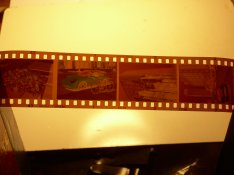The great thing about this thread is that we are finally testing and posting result about using C-41 diluted is that it doesn't work or that color shifts will hunt you while you sleep
I'm a little torn about whether this sort of testing is a good thing or not. On the one hand people are exploring and finding out how things work. On the other hand it seems to be mostly one-sided testing of off-spec methods, not comparing results to those of a "proper" process. The results seem to be largely evaluated in terms of "it looks good to me" or "I'm satisfied/happy with the results." Or if anything is wrong, "I can fix it digitally." I think this can be misleading to casual readers who have little to no experience doing these things, and in the absence of dissenting opinion may see this as strong evidence that all is true.
I personally have some pretty extensive experience with both the C-41 and RA-4 (paper) processes obtained while working for a large studio chain outfit. We were pretty finicky about our materials, testing pretty extensively. When a new paper, or film, was being brought onto the market, and we were considering its use, we'd start a testing sequence. There's a brief rundown in the link below.
https://www.photrio.com/forum/posts/2192714/
For those not reading the link, we shot a variety of subjects - different complexions and hair colors - with different-colored fabrics and a color test chart, and did this over a wide exposure range. Then we optically printed the film - almost always a Kodak professional portrait film onto an appropriate professional paper. From the "normal" exposure we made a "best" color-balanced print, then every other test image was hand-balanced to match colors on the skin tones. Then the images were compared, including versus the actual color chart and an assortment of the actual fabrics (such comparisons must be done under a "proper" light with full-spectrum, such as you get with daylight).
Since our business was portraits, skin tone reproduction was a main priority, so we especially looked for color crosses there, including when both dark and light complexions were in the same image, and at different exposure levels. With Portra 160 it was possible to do this such that both a one-stop underexposed and a four-stop overexposed negative could be printed as a very nearly dead match to the reference print. And our test fabrics, strong red, green, and blue, plus a couple pastels, could be laid next to the actual print and be close enough to believe they could be the same thing (of course this match would not hold up under various different light sources).
I present this as an example of what can be done with a "proper" process and certain professional materials.
Now, I will be the first to admit that I have NO experience with a diluted C-41 developer, nor off-spec temperatures, etc., so I can't say for sure what the results would be. But having worked with this sort of thing for a lot of years, and seeing how finicky things can be, it is MY GUESS that there is almost no chance that a highly diluted developer would be able to match this performance.
Anyway this is my view of the sort of testing that would be useful for someone doing portrait work. And it would ideally be compared to an optimum process. Without such a side-by-side comparison it's easy to be fooled about how good one's results are. As an example, perhaps the off-spec test processes might exceed the best quality available circa 1970s, where it would have been seen as a minor miracle. But today the reference standard is much higher. If one is not comparing the test system directly against a current hi-quality reference, it's hard to know where it fits in.
Ps, as a note, we did various sensitometric tests and color chart evaluations, etc., but found these not adequate to predict performance with portrait subjects. There are too many color variations - mixes of film layer combinations that may interact with each other. So we always included "real world" type testing, based on what we made our living at.
I shall now bow out of this thread




 OK I do know but they are virtually a closed book to me. Other than a very primitive scanner on my HP printer for which I only need to know to press the scan button and it does the rest I know diddly squat about them
OK I do know but they are virtually a closed book to me. Other than a very primitive scanner on my HP printer for which I only need to know to press the scan button and it does the rest I know diddly squat about them
